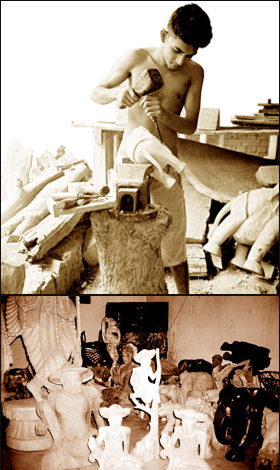The Art of Ebony Elephants
by Ishara Mudugamuwa
[email protected]
Meet one of the richest people in Bope, Galle - millionaire Regis
Wekunugoda - who has been exporting elephants. Definitely not catching
them from the wild or taming them to sell but one who sculptures
elephants from the black wood, ebony.
 This handicraft is a popular and pursued career for many in Galle
whose talent can rival that of India, highly famed for its own wood
carvings. This handicraft is a popular and pursued career for many in Galle
whose talent can rival that of India, highly famed for its own wood
carvings.
This rare timber is fashioned by master artisans known as
‘Hadakaraya’ into even miniature elephants used as keytag souvenirs.
Various religious effigies like ‘Nataraja’, the Hindu deity and Lord
Buddha statues are also formed from this aromatic wood that highlights
beauty and grace.
More than the basic elephant shape, another one called the ‘Hada
Aliya’ is also sculpted that gives the elephant a larger trunk with a
broader arch.
Several stages are required in order to carve such masterpieces. The
primary stage is skilfully creating the image that is in the mind of the
artisan and then fine tuning its intricate details with special tools.
Thereafter, sandpapering and polishing is done to display its finer
attributes making it attractive. Every stage of craftsmanship is vital
in bringing out the best of the masterpiece so that it is a collector’s
item when it goes on sale.
However, today there is a dearth of ebony elephant artisans because
of the fact that the ebony wood is scarce and artisans have to cater to
the demand of the modern-day industry, especially tourism.
They have had to make changes and innovations in their work by using
red and white wood like ‘Pare Mara’, ‘Nadun’ and ‘Alastonia’ and some
even colour the wood black to resemble ebony as a last resort.
There is a tremendous demand from fishmongers who use wood like ‘Pare
Mara’ for their traditional fishing stilts and such timber logs are sent
in many numbers to Bope and Heenpendala where they are created into
religious statues.
Artisans work from dawn to dusk to make meagre earnings and even
though they can give up this up for a more prosperous one, the love for
this art handed down from generations remains true in their hearts. Wood
artisan W. A. Sarath from Heenpendala has been involved in this field
which his family undertook for generations and hopes his son will also
follow suit.
“Ebony wood isn’t available these days and the direct export market
isn’t flourishing because we depend on the tourist season” he said. If
its off-season, their wares are not sold until the next tourist season
making it difficult to make a proper living out of it.
Even today, despite the shortcomings, Galle’s youth are more involved
in taking up after their fathers because with technological
advancements, they have electric tools that make it easier to sculpt
figures.
However, people should realise that this majestic animal in its pride
and glory has been entrusted with holy rituals like the annual Peraheras
for centuries in Sri Lanka’s history. Hence it is vital that we keep a
momentum of appreciation for the elephant and support the ebony elephant
industry. |
